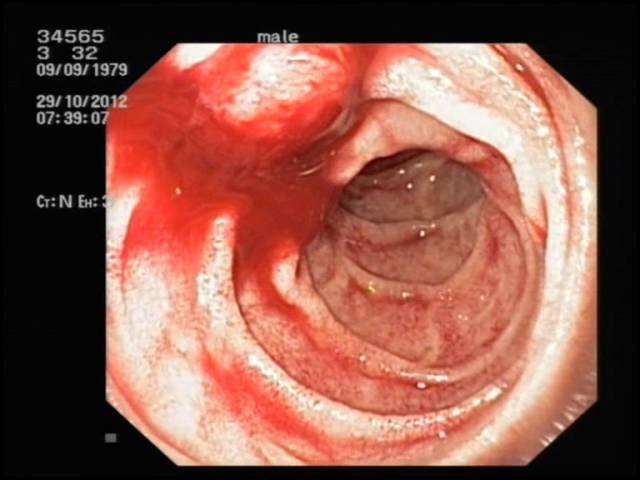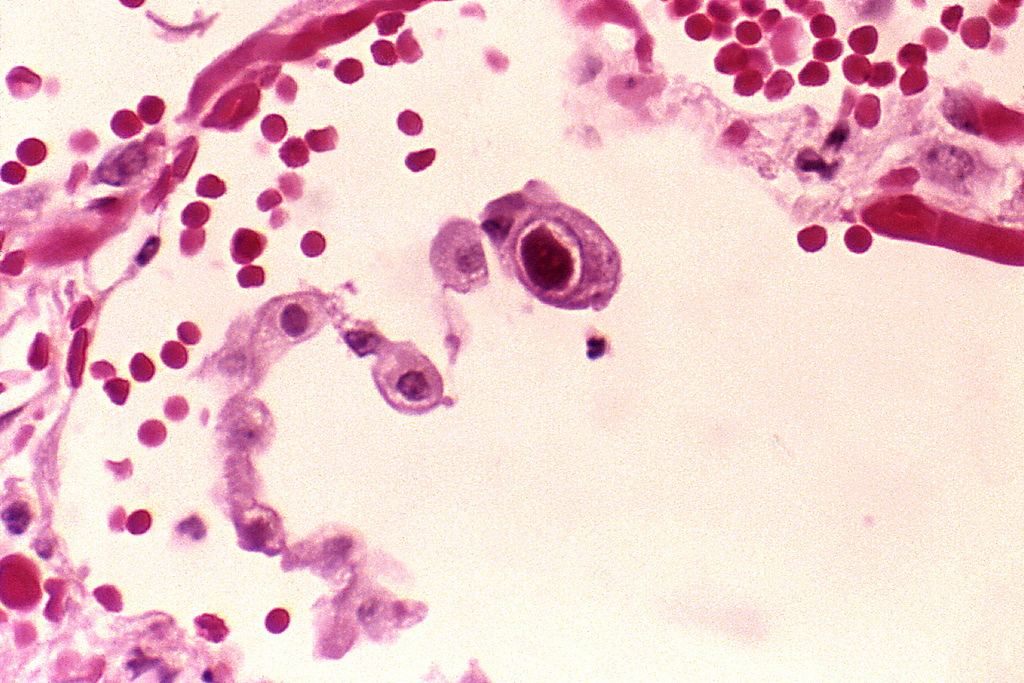Algodismenorea
 Algodismenorea is regularly repeated painful menstruation accompanied by metabolic, hormonal, neurological and psychoemotional disorders. Menstrual pains lead( 8 - 80%) among the complaints addressed to a specialist young women, but their presence is not always associated with gynecological pathology.
Algodismenorea is regularly repeated painful menstruation accompanied by metabolic, hormonal, neurological and psychoemotional disorders. Menstrual pains lead( 8 - 80%) among the complaints addressed to a specialist young women, but their presence is not always associated with gynecological pathology.
Algodismenorea in adolescents is of a functional nature, when examining girls with menstrual pain, organic changes in the genitals are not found. If algodismenorea appeared during the first menstruation( menarche) or within the first year and a half after them, it is classified as primary. Primary algodismenorea appears due to endocrine, neuropsychogenic or constitutional disorders, it is much less likely to develop against the background of malformations of the genitals.
Secondary algodismenrhea always indicates an organic pathology of the genital organs. It appears after a period of normal menstruation and is always accompanied by symptoms of the pathology that it provoked.
As an independent diagnosis, algodismenorea is placed only in the case of its primary origin, secondary algoidismenorea is considered one of the symptoms of the basic gynecologic disease( endomyometritis, endometriosis, myoma, polyp and others).
The leading symptom of algodismenorrhoea of any genesis are different in intensity and duration of menstrual pain. Episodes of painful menstruation happen in life in almost every( 90%) women, but the diagnosis of algodismenorea can be made only to some of them.
Algodismenorea is characterized by the persistence of pain syndrome, when monthly for many years the patient has menstrual pain, and often pain over time increases in intensity. The disease of algodismenorea also includes other symptoms: headaches, dizziness, bowel disorders( bloating, diarrhea, vomiting).It is also characterized by psychoemotional disorders - sleep disturbance, unstable mood.
The cause of algodismenosis is not always obvious, especially in the case of its primary origin, since primary algodismenorea can be associated with dysfunction of many important body systems, but there is no gynecological disease. Algodysmenorrhea of secondary origin is diagnosed symmetrically with the underlying disease and does not require additional diagnostic measures.
The examination of patients with algodismenosis does not have standard schemes and is carried out until the cause of the disease is found. It starts with a routine conversation and gynecological examination, and the result of a diagnostic search can be complex manipulations - MRI, CT, hysteroscopy, laparoscopy. It often requires the help of related specialists - endocrinologists, therapists, neuropathologists.
Treatment of algodismenorea depends on the intensity of the pain syndrome, age and the presence of concomitant gynecological and / or extragenital diseases. Independently to cope with menstrual pains it is possible only at an easy degree of a painful syndrome at absence of organic changes of genitals. However, self-medication does not always have a beneficial effect on the prognosis of the disease. Anesthetics with algodismenore can reduce or eliminate pain, but its cause may remain and provoke further progression of the disease.
Causes of algodismenosis
The menstrual cycle is formed with the participation of all the most important body systems, so the cause of algodismenorea can be found both in the uterus and appendages, and far beyond the genitals.
Secondary algodismenorea appears after a period of normal menstruation and is always associated with gynecological pathology. It is found among the symptoms of external or internal edometriosis, infectious inflammatory processes of the pelvic region( endometritis, salpingoophoritis), submucous( submucous) uterine fibroids, endometrial polyps, adhesions and other ailments. They are the cause of menstrual pain. There are cases of algodismenorea on the background of an intrauterine device.
Algodismenorea in adolescents is primary, appears with the first menstruation with a "healthy" uterus and appendages. Its causes are conventionally classified into groups:
- Mechanical: menstrual pain can be associated with malformations of the genitals: partial or complete infection( atresia) of the cervical canal, abnormal position of the uterus or its underdevelopment. The presence of anomalies in the development of the genitalia leads to a difficulty in the free flow of menstrual blood, it accumulates in the uterine cavity, stretches it and provokes pain.
- Endocrine: excessive contractions of the uterine musculature, resulting in its ischemia, are associated with a violation of the synthesis of prostaglandins - biologically active compounds that control the contractility of smooth muscles.
- Hormonal: algodismenorea often appears on the background of hormonal dysfunction with a deficiency of the second( lutein) phase. The appearance of pain is due to the excessive effect of estrogens with insufficient progesterone concentration.
- Constitutional: in case of sexual infantilism, the uterus is hypoplastic, and its musculature is not developed enough and is not stretched due to the accumulation of menstrual blood.
- Neuropsychogenic: painful menstruation often appear in girls with a labile psyche and a low pain threshold.
It should be noted that the concept of pain with menstruation in different patients is not the same. It is determined by the individual pain threshold. If, in the examination, the patient with algodismenosis has no organic pathology, there are no accompanying systemic symptoms and the progression of pain intensity, one can talk about the physiological features of the perception of pain.
Symptoms and signs of algodismenosis
Primary algodismenorea is more often diagnosed in young women and girls with asthenia with a deficiency of body weight and a labile psyche. Secondary menstrual pain is more typical for overcoming the 40-year-old line of patients with a history of abortion, gynecological diseases and operations, long-term infertility.
As already mentioned, primary and secondary algodismenorea have several important diagnostic differences:
- Age of appearance and age of patients. Menstrual pains of a primary genesis arise in the period from the first menstruation to the moment of formation of a full-fledged two-phase cycle with ovulation. Usually this time interval does not exceed one and a half years.
Secondary algodismenoreia manifests in more adult women, and it is always preceded by a period of normal menstrual cycles.
- Presence of concomitant gynecological pathology. Primary algodismenorea refers to functional states and has no organic causes. When examining girls with primary menstrual pains of gynecological diseases, they do not detect, but diagnose numerous systemic( non-genital) disorders of a functional nature. Each second patient is characterized by a combination of menstrual pain and symptoms of premenstrual syndrome( PMS).
Secondary algodismenrhea is always accompanied by signs of organic damage to the genitals and is considered as one of its symptoms.
- Signs of systemic dysfunction. Primary algodismenorea is always combined with clinical manifestations of metabolic, endocrine, nervous, vegetative and psychoemotional systems. Secondary algussmenorea can also be accompanied by such disorders, but they always appear against the background of the basic gynecological ailment.
The leading, permanent clinical sign of algodismenosis of any origin is menstrual pain. As a rule, they begin on the eve( 12 hours) of regular menstrual periods or coincide with the onset of menstrual bleeding. The duration of pain usually varies within two hours and two days, sometimes pain accompanies the entire menstrual period.
Pain syndrome can maintain intensity and duration for many years without progression, in which case algodismenore is considered compensated.
Sometimes the nature of pain is aggravated over time, there are accompanying pathological clinical symptoms, and then algodismenorea passes into the category of decompensated disease.
Menstrual pain is also classified according to the degree of severity.
The first, mild, algodismenoreal degree is characterized by moderate pelvic pain during menstrual bleeding. Painful feelings of the patient usually characterize as pulling, aching and short, sometimes they are associated with the usual discomfort during menstruation, which does not break the habitual rhythm of life. Anesthetic tablets for algodismenorrhea of the first type are not required. This degree of disease often does not tend to progress. Such algodismenorrhea of the patient is more often perceived as ordinary menstruation and, if her symptoms are not aggravated with the passage of time, do not seek help from a specialist.
Moderate, the second, the degree of algodismenorea is manifested by more intense pelvic pains in combination with other, systemic, symptoms. If algodismenorea is secondary, along with pelvic pain, signs of a major disease appear. The pains affect the patient's well-being, therefore they require a medical correction. The usual painkillers for algodismenorrhea of the second degree quickly relieve the pain and positively affect the overall well-being.
The third, severe, degree of algodismenrhea is characterized by painful menstrual pains on the background of severe systemic disorders. The patient is deprived of the opportunity to lead a familiar life, forced to spend all the time in bed. Self-administered tablets with algodismenorea severe do not bring relief.
Diagnosis of the causes of algodismenosis begins with the search for organic causes. After studying complaints and gynecological examination, a laboratory study is carried out. It includes tests( swabs, crops, etc.) for the presence of infection and the study of the content of major hormones( FSH, LH, estrogens, progesterone and others).To assess the status of the uterus and appendages, as well as assess the condition of neighboring pelvic organs, ultrasound scanning, hysteroscopy. In complex clinical situations, diagnostic laparoscopy is required.
If after a full diagnostic search no organic gynecological pathology is detected, algodismenorea is correlated with a physiological disorder and is considered primary.
Primary algodismenorea
As already noted, the first symptoms of primary algodismenrhea appear during the period of the menstrual cycle and are not associated with any gynecological pathology. The intensity and duration of pain depends on the degree of the disease. Pain can be aching, pressing, bursting, and also are cramping. Sometimes menstrual pain irradiates to the organs and / or lower back, adjacent to the uterus.
Pain repeats every cycle and is accompanied by systemic symptoms that can be conditionally divided into groups:
- Vegeto-vascular disorders: fainting, dizziness, migraine, pain in the heart and palpitations, facial swelling, numbness in the limbs, and others.
- Vegetative disorders: nausea, eructation, diarrhea, sweating, chills and others.
- Exchange-endocrine disorders: joint pain, weakness in the legs( "cotton feet"), general malaise, swelling, itching of the skin and others.
- Psychoemotional changes: irritability, tearfulness, drowsiness, depressive states, obsessive fears and others. In turn, algodismenorea itself provokes a change in the emotional state of girls, as waiting for another painful menstruation adversely affects the mood of patients.
In a more severe form, algodismenorea occurs in asthenic girls with psychopathic personality traits. Neurovegetative disorders in them develop maximally and are expressed in dyspnea, attacks of suffocation, changes in blood pressure, intestinal disorders( flatulence, diarrhea), headaches, increased fatigue.
Diagnostic search for the causes of primary algodismenrhea helps to facilitate an attentive external examination, which can often be identified:
- vascular nets on the back, limbs, breasts due to thin skin( the vessels are visible through it);
- hemorrhagic manifestations( petechiae) after the so-called "sample tweezers";
- skeletal abnormalities: change in the shape of the chest( keeled, funnel-shaped), pathology of the spine( scoliosis, kyphosis and others), flat feet;
- external signs of varicose veins;
- presence on the surface of the thighs, buttocks and / or chest intradermal, similar to postpartum, ruptures and streaking( "striae").
For a full-fledged examination, adjacent specialists are involved: neuropathologists, endocrinologists, therapists, since the success of treatment depends on a reliable assessment of the degree of functional disorders in the patient.
Girls with primary algodismenosis often have extragenital pathology: vegetative-vascular dystonia, mitral valve prolapse, flat feet, posture disorder( scoliosis, kyphoscoliosis), myopia and others.
Secondary algodismenorea
As an independent gynecological pathology, secondary algodismenorrhea is not worth considering, since it is always a symptom of the underlying disease.
Menstrual pains are often accompanied:
- Endometriosis. The disease has a proven hormonal nature. The essence of the pathological process in endometriosis is the appearance of areas of the endometrium beyond its normal location: more often in the thickness of the myometrium, on the neck, in the ovaries, on the peritoneum, it is also possible the appearance of endometriotic sections in the lungs, on the skin, in the intestine.
Once in the "wrong place", the endometrial tissue tends to perform its basic function, so it mimics menstruation, that is, grows and tears away with the release of blood.
If endometriosis affects the uterus( adenomyosis), the endometrial sites grow in the depth of the muscular wall. The processes of normal contraction of the uterine musculature are deformed. Characterized by the appearance of pain in a few( 5-7) days before menstruation, their intensity gradually increases and reaches the greatest value by 2 - 3 days, and then begins to decline, completely pain passes only to the middle of the cycle.
Menses in adenomyosis are abundant and longer due to prolonged spotting on the eve and after the menstruation.
- Hysteromyoma. The presence of myomatous( single or multiple) nodes in the wall of the uterus prevents it from contracting properly and provokes pain. If the myoma grows toward the uterine cavity, a submucosal( submucous) node is formed. The uterus perceives it as a foreign body and tries to tear it away, with very severe pains that can continue not only in the menstrual period.
- Adhesive process. More often spikes are a consequence of inflammatory processes in the pelvic cavity, when the inflammatory exudate becomes dense cords limiting the normal mobility of the pelvic organs. The pain in the presence of adhesions in the small pelvis is of concern to the patients during the intermenstrual period, and during the menstrual period they become more intense.
Treatment of algodismenorea
The approach to treatment of primary and secondary algodismenosis is unequal. To eliminate secondary algodismenorrhea, it is necessary to cure the underlying disease, for the period of treatment menstrual pain is relieved by anesthetics.
Primary algodismenorea therapy implies correction of all available systemic disorders, therefore it is a long process. There is no universal treatment regimen for everyone, for each patient it is made up personally according to the severity of the pain and the nature of the accompanying systemic manifestations.
For the treatment of primary algodismorrhoea use:
- Nonsteroidal anti-inflammatory drugs: Nimesil, Naproxen, Indomethacin, Ibuprofen, Aspirin and the like. They block the excessive synthesis of prostaglandins, thereby reducing the intensity of pain. With intensive pain, these funds should be prescribed two days before the onset of menstruation with the goal of preventing severe pain.
- Analgesics and antispasmodics for direct action on the uterine musculature: No-shpa, Baralgin, Spazmalgon and analogues.
- Vitamins "Unicap", "Multitabs", "Decamewith".
- Tranquilizers and sedatives: Tazepam, tincture of valerian and others.
- Antioxidants: Vitamin E in continuous mode for a long time.
- Preparations based on magnesium salts: Magne-B6 and analogues. It is established that magnesium takes part in the transmission of the nerve impulse and the formation of the mechanism of muscle contractions, and with primary algodismenore there is a deficit.
- Hormonal preparations. Assigned to girls with signs of hormonal dysfunction and insufficiency of the luteal phase of the cycle. Preliminary hormonal examination is performed, and the menstrual cycle is adjusted according to its conclusion.
If the amount of estrogen remains within normal limits, the deficiency of the luteal phase is compensated by gestagens. Severe degree of algodismenoreism on the background of an excess of estrogens requires the appointment of monophasic hormones: Logest, Lindineth, Janine and the like.
The popularity of homeopathic therapy of primary algodismenosis is growing. In combination with medication, physiotherapy is also used.
Correctly chosen tactics of therapy helps to save patients from menstrual pain.



